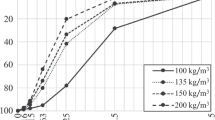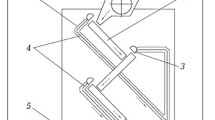Abstract
Vermiculite, a mineral of natural occurrence of the group of hydromicas, when heated to above 300°C, expands to become a highly efficient heat-insulating material. The expanded vermiculite, owing to its unique properties – low bulk density, low heat conductivity, relatively high melting point, chemical inertness, endurance, and environmental safety – can be used as a filler for heat-insulating materials. Heat insulators based on expanded vermiculite can be used in thermal power units with the hot-wall temperature not exceeding 1150°C as replacement for lightweight chamotte components and fibrous heat insulators.
Similar content being viewed by others
REFERENCES
“Vermiculite board big in Australia, ” Ceram. Ind. (USA), 133(3), 18 (1989).
N. I. Abramova, V. Ya. Grinberg, and S. V. Zhebrunov, “Heat insulators based on expanded perlite for steel teeming technology, ” Ogneupory, No. 12, 11–14 (1990).
T. Stelmah, “Perlite in the production of lightweight bricks, ” Tile and Brick Int., 6, No. 6 (1990).
“Une experience de production de briques legeres avec incorporation de perlite, ” Ind. Ceram. Int., No. 6, 404 (1993).
I. M. Maizel', “Expanded perlite for engineering components, ” Byull. "Novye Tekhnologii", No. 4, 18–19 (1995).
E. K. Jungk, H. Halceband, K. Elett, and W. Kremar, “Porosities for the production of lightweight bricks, ” Tile and Brick Int., 13(1), 7–12 (1997).
N. M. Permikina and Z. U. Evdokimova, “Heat-insulating refractories based on spherical corundum for the lining of hightemperature furnaces, ” in: Refractories-91: Technology and Applications. All-Russia Research Workshop. Abstracts [in Russian], VostIO, Chelyabinsk (1991), p. 56.
“Low density refractory supports, ” Ceram. Ind. Int., 103 (1099), 20 (1993).
N. A. Popov (ed.), Production and Applications of Vermiculite [in Russian], Stroiizdat, Moscow (1964).
Vermiculite from the Kovdorskoe Deposit [in Russian], Kola Branch of the Russian Academy of Sciences, Apatity (1966).
G. A. Krinari, A. I. Bakhtin, A. I. Vezentsev, and T. A. Kozlenko, “Vermiculization of the trioctahedral mica, ” in: 14th International Conference on x-ray Crystallography of Minerals Devoted to the 90th Anniversary of the Birthday of G. B. Bokii. Abstracts [in Russian], St. Petersburg State University, St. Petersburg (1999), p. 228.
Ya. A. Akhtyamov, “Today's raw materials base for the vermiculite industry in Russia, ” Stroit. Mater., No. 11, 6–8 (2001).
E. Moeller, “Vermiculite, ” Mining Eng. (U.S.), 52(6), 66–67 (2000).
J. Bors, A. Gorny, and S. Dultz, “Iodide, cesium and strontium adsorption by organophilic vermiculite, ” Clay Miner., 32(1), 21–28 (1997).
W. K. Melkhaner and F. F. Assaad, “Thermodynamics of Sr – Mg vermiculite exchange and the effect of PVA on Mg release, ” Thermochim. Acta, 334(1 – 2), 33–38 (1999).
S. É. Kaminskii, S. B. Shibryaev, I. A. Lyubinin, and V. L. Nemets, “Vermiculite as a component for thread lubricants, ” Khim. Tekhnol. Topliv i Masel, No. 1, 17–18 (1994).
Yu. N. Vasil'ev, V. V. Ivanenko, and V. A. Fugol', “RF Patent No. 2001056. A composition for absestos-free friction material, ” Izobreteniya, No. 18 (2001).
P. P. Gedeonov, “Expandable fireproof coatings based on vermiculite, ” Stroit. Mater., No. 7, 16–18 (1991).
Ya. A. Akhtyamov, B. S. Bobrov, G. B. Gemmerling, et al., Technology of Vermiculite Calcination [in Russian], Stroiizdat, Moscow (1972).
A. P. Polenin, “Crystal chemistry formulas in the study of the properties of minerals (as exemplified by micas and hydromicas), ” in: Building Materials from Industrial By-Products. Collection of Research Papers [in Russian], LISI Research Institute, Leningrad (1976).
Physicochemical Studies of Hydromicas: Papers Reported to a Conference “The Uses of Vermiculite in Civil Engineering, ” [in Russian], Chelyabinsk (1965).
N. A. Akhtyamov and G. B. Gemmerling, “A way toward improving the expansion of vermiculite, ” in: Building Materials and Castables [in Russian], UralNIIstromproekt, Chelyabinsk (1969).
N. A. Akhtyamov, G. B. Gemmerling, V. Ya. Spirina et al., “A study of fine-grained vermiculite from the Potaninskoe deposit, ” in: Vermiculite [in Russian], Stroiizdat, Moscow (1965).
B. S. Bobrov, Yu. E. Gorbatyi, and M. B. Épel'baum, “An x-ray diffractometry study of the changes in phase composition of vermiculite on heating, ” in: Vermiculite [in Russian], Stroiizdat, Moscow (1965).
V. Ya. Spirina and R. Ya. Akhtyamov, Ceramic Vermiculite Components for the Lining of Thermal Power Plante in the Building Materials Industry (A Review) [in Russian], VNIIÉSM Research Institute, Moscow (1991).
A. P. Fandeev, N. A. Vinogradov, V. P. Tataurov, and V. A. Kuznetsov, “New heat-insulating materials based on vermiculite and diopside for aluminum electrolyzers, ” in: State-of-the-art in the Production of Aluminum, Magnesium and Electrode Materials [in Russian], AO VAMI, St. Petersburg (1992), pp. 59–63.
B. V. Vazhenin and V. V. Kotel'nikov, “The use of ceramic vermiculite for heat insulation of glass-melting furnaces, ” in: Production and Applications of Vermiculite, UralNIIstromproekt, Chelyabinsk (1983).
R. Ya. Akhtyamov, O. V. Glukhovtsev, and P. P. Trofimov, “Protective guards from vermiculite components for use in the reconstruction of furnaces, ” in: Building Materials Industry. Series 4. Industry of Ceramic Materials and Porous Fillers, Issue 6 [in Russian], VNIIÉSM Research Institute, Moscow (1983), pp. 9–11.
S. A. Suvorov, V. V. Bagin, V. S. Spirina, and I. G. Zhugin, “A ceramic vermiculite heat-insulating material with a diatomaceous binder, ” in: Heat-Insulating Materials and Components Based on Vermiculite, Mineral Wool, and Cellular Concrete [in Russian], UralNIIstromproekt, Chelyabinsk (1990), pp. 58–67.
S. A. Suvorov, V. V. Bagin, V. S. Spirina, and M. V. Balina, “Two-layer ceramic vermiculite components with improved temperature resistance, ” in: Heat-Insulating Materials and Components Based on Vermiculite, Mineral Wool, and Cellular Concrete [in Russian], UralNIIstromproekt, Chelyabinsk (1990), pp. 45–52.
V. V. Kotel'nikov and V. S. Spirina. “Thermal physical properties of ceramic vermiculite and its use in heat insulators for glass-melting furnaces, ” in: Heat-Insulating Materials and Components Based on Vermiculite, Mineral Wool, and Cellular Concrete [in Russian], UralNIIstromproekt, Chelyabinsk (1990), 52–57.
V. V. Bagin, V. S. Spirina, A. N. Zhuchkova, and M. V. Balina, “Ceramic vermiculite compositions of improved temperature resistance, ” in: Efficient Heat-Resistant Materials and Structures for Thermal Power Plants in the Building Materials Industry [in Russian], UralNIIstromproekt, Chelyabinsk (1990), pp. 121–134.
M. P. Goldobin, “An efficient heat-insulating material, ” Stroit. Mater., No. 7, 11 (1996).
I. I. Shakhov, “Updating the lining for tunnel kiln wagons, ” Stroit. Mater., No. 1, 20–21 (2001).
V. S. Spirina, G. V. Gemmerling, and Ya. A. Akhtyamov, “Properties of Ceramic Vermiculite Components, ” Building Materials and Castables. Collection of Research Papers [in Russian], UralNIIstromproekt, Chelyabinsk (1967), pp. 206–217.
V. S. Spirina, “Ceramic vermiculite components: production and uses for high-temperature insulation, ” in: Production and Applications of Vermiculite. Collection of Research Papers [in Russian], UralNIIstromproekt, Chelyabinsk (1983), pp. 43–48.
V. S. Spirina, A Study Into the Composition, Technology and Properties of Heat-Insulating Ceramic Vermiculite-Based Products, Author's Abstract of Candidate's Thesis [in Russian], Chelyabinsk (1971).
S. A. Suvorov, V. V. Bagin, V. S. Spirina, and M. V. Balina, “USSR Inventor's Certificate No. 1583395, Amethod for fabrication of heat-insulating ceramic vermiculite components, ” Byull. Otkr. Izobr., No. 29 (1990).
V. V. Bagin, V. A. Vavilov, V. S. Spirina, and L. D. Kabysh, “USSR Inventor's Certificate No. 1502319, A device for shaping the building engineering components, ” Byull. Otkr. Izobr., No. 14 (1989).
V. A. Mozhzherin, V. Ya. Sakulin, V. P. Migal', A. N. Novikov, G. N. Salagina, E. A. Shtern, S. A. Suvorov, V. V. Skurikhin, and G. V. Filin, “RF Patent No. 2154042, A high-temperature heat-insulating material and a method for its fabrication, ” Izobr., Zayavki, Patenty, No. 22 (2000).
V. A. Mozhzherin, V. Ya. Sakulin, V. P. Migal', A. N. Novikov, G. N. Salagina, E. A. Shtern, S. A. Suvorov, V. V. Skurikhin, and V. V. Bulin, “RF Patent No. 2155735, Anonfired high-temperature heat-insulating material and a method for its fabrication, ” Izobr., Zayavki, Patenty, No. 25 (2000).
S. A. Suvorov and V. V. Skurikhin, “High-temperature heat-insulating materials based on expanded vermiculite, ” in: Progress in Chemistry and Material Engineering. Collection of Research Papers: “A Week's Workshop on Chemical Technologies in St. Petersburg” Conference, St. Petersburg, 28 – 31 October, 2002 [in Russian], St. Petersburg (2002), pp. 27–30.
R. Ya. Akhtyamov, V. A. Shchetinkin, O. N. Popov, et al., “Expanded vermiculite as a heat insulator for the arch of glass-melting furnaces, ” Steklo Keram., No. 2, 29–39 (1986).
Author information
Authors and Affiliations
Rights and permissions
About this article
Cite this article
Suvorov, S.A., Skurikhin, V.V. Vermiculite — a Promising Material for High-Temperature Heat Insulators. Refractories and Industrial Ceramics 44, 186–193 (2003). https://doi.org/10.1023/A:1026312619843
Issue Date:
DOI: https://doi.org/10.1023/A:1026312619843




